Traveling the Silk Road – The History of Silk
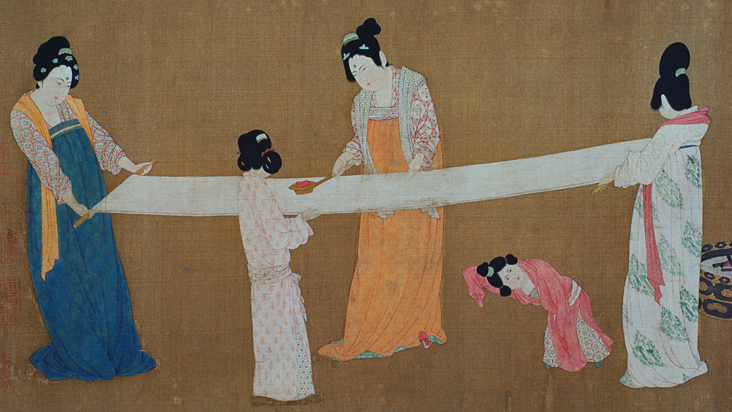 A painting depicting women inspecting silk, early 12th century, ink and color on silk, by Emperor Huizong of Song
A painting depicting women inspecting silk, early 12th century, ink and color on silk, by Emperor Huizong of Song
For hundreds of years, China tightly controlled the production and manufacture of silk, making it the most prized of all fabrics.’ The desire for silk created thousands of miles of trade routes as well as advances in stocking knitting and the creation of the first imitation fabrics. Come with us on a journey along the silk road to discover the history of silk.
The Humble Silkworm
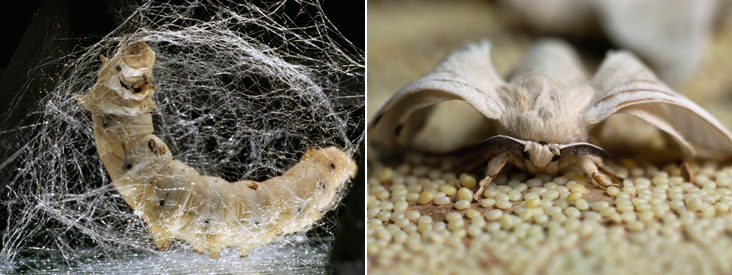 A Bombyx mori larva ejecting a silk fiber to make its cocoon which will take about two weeks of work. / After several hours of mating, the adult female Bombyx mori deposits as many as 500 pinhead-size eggs. Two or three days later she dies.’
A Bombyx mori larva ejecting a silk fiber to make its cocoon which will take about two weeks of work. / After several hours of mating, the adult female Bombyx mori deposits as many as 500 pinhead-size eggs. Two or three days later she dies.’
Silk comes from fibers of the cocoon of the’ Bombyx mori’ moth. There are many wild varieties of the silk moth but only the Bombyx mori has fibers strong enough to make into fabric.’ Legend has it that Chinese princess, Si Ling-chi (c. 2640 BCE), discovered silk when a cocoon fell out of a tree and into her cup of tea. The hot tea dissolved the hard gum surrounding the cocoon and allowed the princess to unravel the cocoon as a single strand.’ Today, silkworms are completely domesticated as the result of ‘ 5000 years of selective breeding. They no longer exist in the wild.’ Because of domestication, the adult moths have completely lost their ability to fly. They have also been bred to be larger, heartier, and produce more silk.
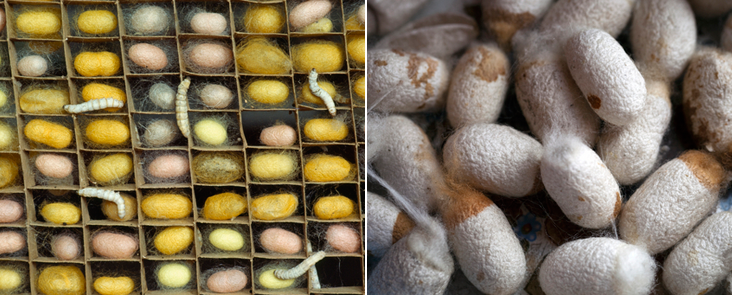 Beautifully coloured cocoons from a few of 300 varieties of domesticated silkworms. The colors come from a gummy substance called sericin which is washed out when the cocoons are processed. /’ Cultivated cocoons harvested from imported Chinese silkworms.
Beautifully coloured cocoons from a few of 300 varieties of domesticated silkworms. The colors come from a gummy substance called sericin which is washed out when the cocoons are processed. /’ Cultivated cocoons harvested from imported Chinese silkworms.
Silk worms survive in very narrow temperature range between 68-86 degrees Fahrenheit and their natural diet consists entirely of mulberry leaves. Industrial silkworm farms use an artificial food for the worms instead of fresh leaves. Over its lifetime, a silkworm eats 40,000 times its own weight! It takes about 14 days from hatching for a silkworm to grow large enough to spin a cocoon. Then the cocoons are either harvested or left to hatch for breeding.’ The cocoon is spun from a single strand of silk, which can be 1000-3000 feet long.
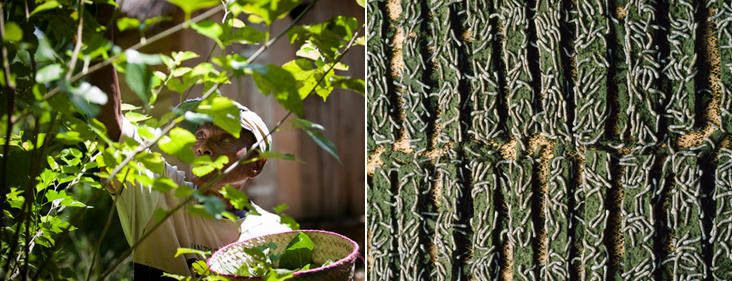 Real v artificial silkworm’ food: A farmer picks mulberry leaves to feed his imported Chinese silkworms. /’ Thousands of hungry mulberry silk moth larvae feast on artificial food consisting of mulberry leaves, soybeans, and cornstarch.
Real v artificial silkworm’ food: A farmer picks mulberry leaves to feed his imported Chinese silkworms. /’ Thousands of hungry mulberry silk moth larvae feast on artificial food consisting of mulberry leaves, soybeans, and cornstarch.
It takes 2000-3000 cocoons to make one pound of silk. China leads the world in silk production followed by India, Uzbekistan, and Thailand. The United States leads the world in silk consumption followed by’ Italy, Japan, India, and France. Overall, silk is less than’ 0.2% of the world textile market.
Discovery in China
However silk was discovered, the secret to its production was heavily guarded in ancient China. Transport of silkworms outside of China was punishable by death. Only fully woven silk goods were allowed out of China and were traded all over Asia. In the 1st millennium BCE, Chinese emperors used silk goods to bribe Central Asiatic nomads to keep them from destroying Chinese cities. Silk also made its way into Greece and Western Europe by the middle of the 1st millennium. Silk traveled’ over sea into Japan and later into the Roman empire, but it is said that they did not know its exact’ origin.
European Silk Industry
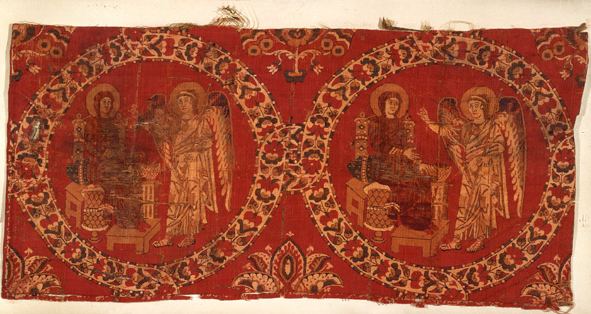 Annunciation, 8th-9th century. Made in Alexandria or Egypt, Syria, Constantinople (?). Weft-faced compound twill (samit) in polychrome silk. Vatican Museums, Vatican City
Annunciation, 8th-9th century. Made in Alexandria or Egypt, Syria, Constantinople (?). Weft-faced compound twill (samit) in polychrome silk. Vatican Museums, Vatican City
In 552 CE Byzantine’ Emperor Justinian sent two monks on a mission to China. They came back with silkworms and cocoons hidden in their walking sticks, probably one of the first examples of industrial espionage in the history of the world. From these silkworms, sericulture, the science of breeding silkworms, spread throughout Asia minor and Greece. In the 7th century CE, Arab conquest of Persia helped to continue the spread of sericulture and silk weaving. Andalusia became the main center silk production in Europe. The crusades, Marco Polo’s journey, and the formation of the Mongol Empire created even more outlets for silk. Italy started a silk industry in the 12th century.
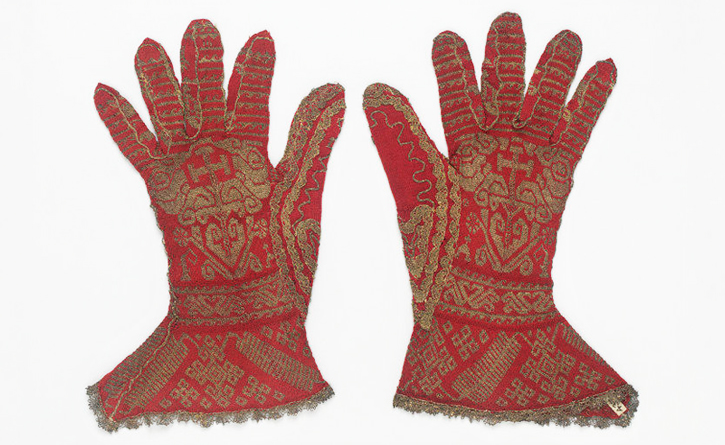 Knitted silk gloves worn by a bishop. Spain, 15th century
Knitted silk gloves worn by a bishop. Spain, 15th century
In 1536, François I of France gave Lyon the monopoly of silk imports and trade. This created the Lyon silk industry, which dominated all of France until the French revolution. Many French Huguenots fleeing religion persecution in 1685 were expert weavers. They contributed to silk industries in Germany, Great Britain, Switzerland, and Italy. France’s loss was to the gain of the rest of Europe.
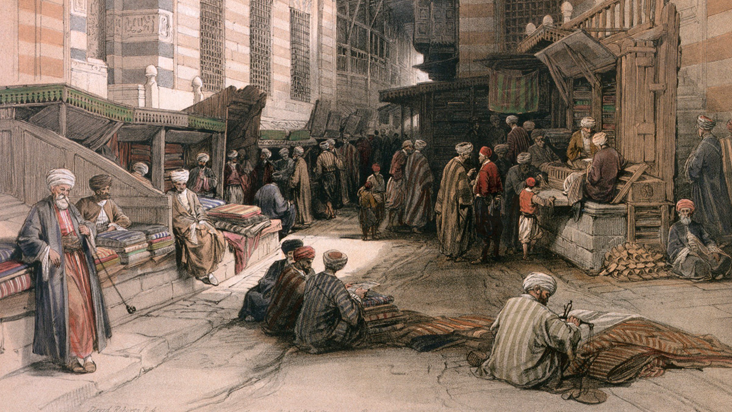 Silk Merchants in Cairo, Egypt ca 19th century.
Silk Merchants in Cairo, Egypt ca 19th century.
Trade also took place by the sea, between Roman Egypt and the west coast of India. Sailors had discovered the “trade winds”, which blow reliably from the southwest in the summer, allowing heavily laden ships to sail across the Indian Ocean from the coast of Africa to India.
The Silk Road served not only for trade but also as a means of communication. Messages and ideas could move anywhere between China and France over its 9941 mi (16000 km)’ long network of roads and paths.
For the Love of Silk Stockings
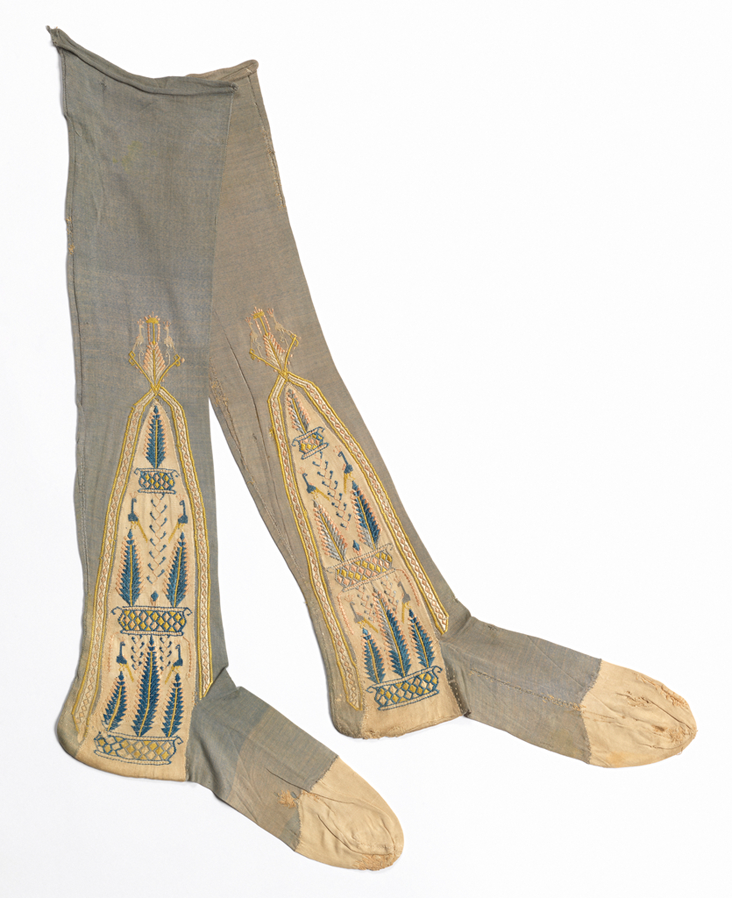 Pair of Men’s Stockings, France, early 19th century, Knitted silk
Pair of Men’s Stockings, France, early 19th century, Knitted silk
Queen Elizabeth I had a love for silk stockings. These were expertly knitted by hand of fine silk thread, having upwards of 20-30 stitches to the inch. They were knee-length and took a considerable time even for skilled knitters to finish. William Lee invented a mechanical frame that could produce a knitted fabric for stockings. This fabric could be cut and sewn in the shape of a stocking in a fraction of the time that it took to knit one by hand. Lee presented his frame to Queen Elizabeth in 1589. She feared its impact on the hand-knitting industry would put hundreds, if not thousands, of stocking knitters out of work and hurt the English economy. Because of this, she did not grant Lee a patent for his frame. Lee improved his frame and again tried to get a patent with James I, who also refused. Lee moved to France and started a fledgling frame-knitted stocking industry but died in 1614. His apprentice further improved upon the machine and machine-knit stockings finally gained popularity in 1700s when there was demand for cheap cotton stockings. Knitting frames were made to handle silk, cotton, and even wool and began to churn out cheaper, frame-knit stockings. The finest stockings were still hand-knit but the frame-knit stockings provided an affordable alternative for most people.
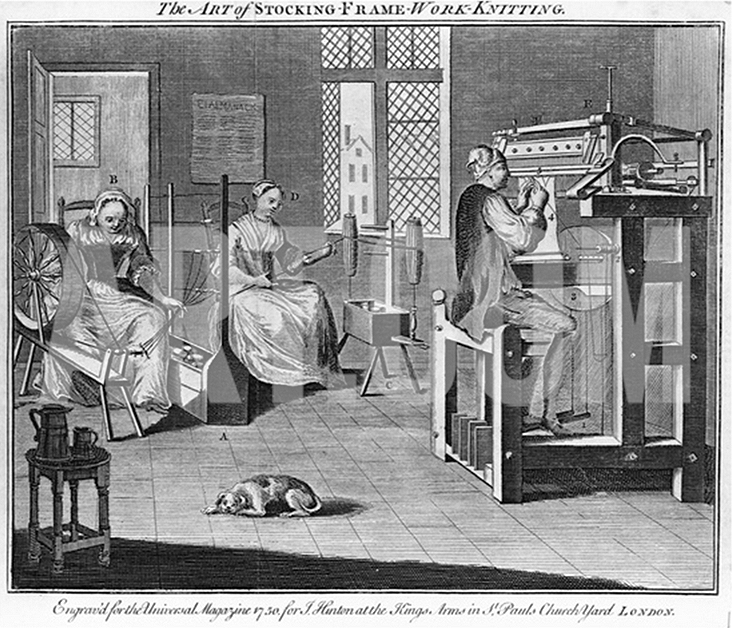 The Art of Stocking Frame Work Knitting English Engraving, 18 century
The Art of Stocking Frame Work Knitting English Engraving, 18 century
Sericulture in the early United States
James I encouraged the settlers of Virginia to produce silk. They imported silkworms and went about trying to raise and farm silkworms. Sericulture is an incredibly labor intensive process as the silkworms have to be monitored and fed regularly to produce quality silk. The silkworms also did not like the native mulberry trees. Tobacco eventually won out as a cash crop and silk production was dropped altogether.
In 1868, an amateur entomologist had the idea to cross the European gypsy moth with the silkworm to produce a species of moth that would spin silk and be able to thrive in the United States. He accidentally released some of the gypsy moths near Boston, which ended up creating an invasive population that continues to devastate trees all over the US to this day.
Silk Substitutes
Because of the expense and generally limited nature of silk, it is no wonder that the first man-made fabric was used as a substitute for silk. Viscose, known commercially as rayon, was created in the late 1800s and originally called’ “Artificial Silk” in 1905 when it went on the market. Rayon was originally created from wood pulp. A chemical process breaks down the cellulose in the wood pulp, which can then be spun like thread. Today, rayon is made from a variety of plant bases such as soy, bamboo, corn husks, and banana peels.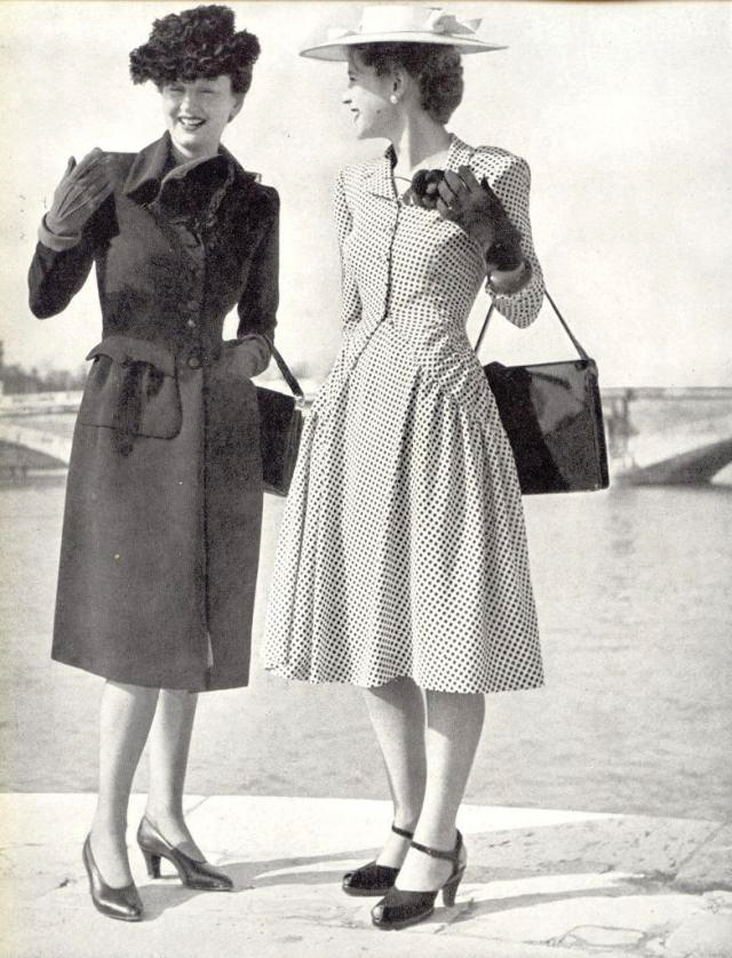 1940s Rayon Dresses
1940s Rayon Dresses
Rayon came into popularity in the 1940s when silk was heavily rationed for use in parachutes and other military items during WWII. Colorful print dresses of rayon fabrics were very popular and were easier to take care of than silk. Nylon and other synthetic fabrics wouldn’t be around until after the war. They were created using petrochemicals and gasoline was also heavily rationed during the war.
Silk Today
Even though silk is less than 0.02% of the overall fabric market, it is still affordable and available in every price range today. Where once Marco Polo marvelled that common soldiers in Mongolia wore silk, today silk can be found everywhere from big box stores to trendy boutiques.
Of course, designers still love silk where it can be found in everything from suits to runway gowns.
 Silk gown and suit from Ralph Lauren Ready To Wear Spring/ Summer 2012
Silk gown and suit from Ralph Lauren Ready To Wear Spring/ Summer 2012
Don’t let silk scare you away. It’s a great fabric for every day wear to evening wear. You can even gently hand wash many silk garments by hand. What do ‘ you think people did before dry cleaners? Indulge in a little luxury and try some silk today!






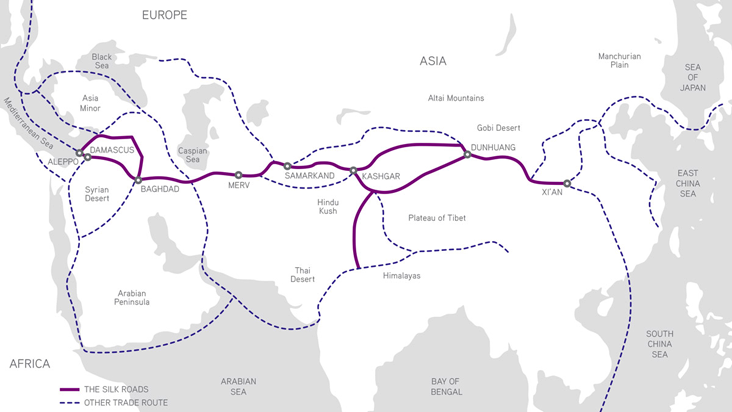
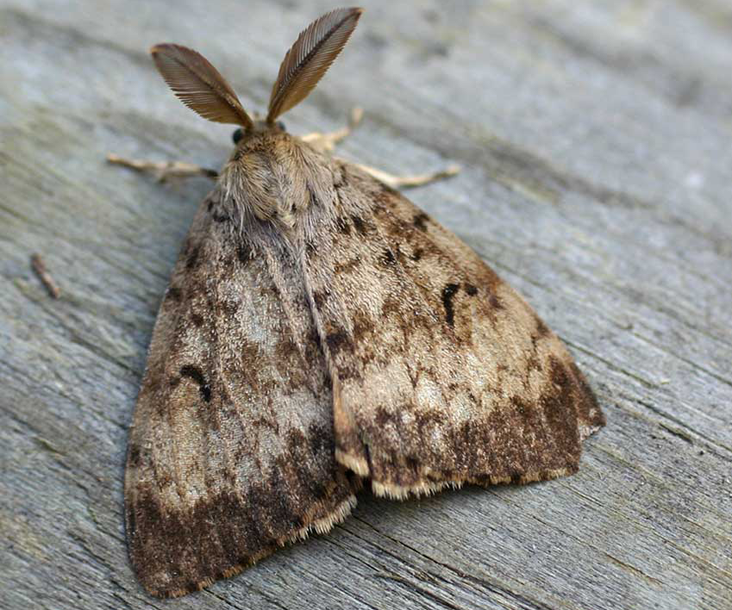

















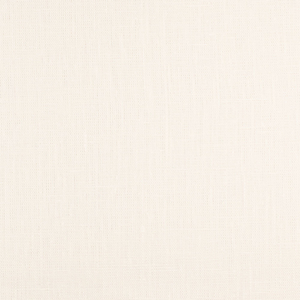



















7 Comments
Jane
I really enjoy these articles on fabric histories as someone who has been sewing for nearly 50 years, (I started sewing at age 12, taught by a family friend). I would argue that silk is no longer affordable. I have silk clothing items from 10 years ago, which I hang onto, as it is disappearing from all but the extremely high priced retailers. Most of the garments at even Macy’s and Nordstroms which resemble silk, are in fact polyester, (sigh).
If you are considering selling silk by the yard, please do so. Thanks for the great articles.
Jan
I too have enjoyed reading these articles. I have always been intrigued with silk and enjoyed this article.
vicku b
Love the articles on the history of didderent fabrics. Always interesting and learning at the same time////keep up the good work.
Peggy
I am so happy that you offer these articles on the history of fabrics. It is as if I am taking history classes and I have always enjoyed history of any kind. I sew fairly frequently and the information I learn from your articles makes the experience even more fun and interesting. Thank you so much!!
Terri
Thanks from me as well. I was a home ec. major in college, and this article gave me much more information about silk than I learned back then (in the “Dark Ages.” LOL
Deborah
I agree with Janet. Keep these articles coming, they are a fascinating read! Thanks so much for this educating series.
Janet
Thank you for this interesting and informative article. I hope you will continue to provide this educational series. I have enjoyed reading every article!